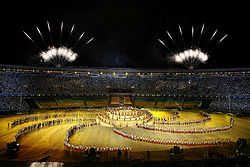
 Mirror
Mirror
The Estádio Jornalista Mário Filho, commonly called Estádio do Maracanã ("Maracanã stadium"), is an open-air stadium in Rio de Janeiro, Brazil. Owned by the Rio de Janeiro State Government, it is named after the Maracanã neighbourhood in Rio de Janeiro. It was opened in 1950 to host the FIFA World Cup. Since then, it has mainly been used for football matches between the major football clubs in Rio de Janeiro, including Flamengo, Fluminense, Botafogo and Vasco da Gama. It has also hosted a number of concerts and other sporting events. Although the paid attendance at the final game of the 1950 FIFA World Cup was 199,500, the stadium currently seats 95,000 spectators.[1] Despite the reduction in capacity it remains the largest stadium in South America, and the twelfth largest in the world.
It is due to host the World Cup Final in the 2014 World Cup, becoming the second stadium to host football's most important match twice after the Azteca Stadium in Mexico City.
Opening
The opening match of the stadium took place on June 16, 1950. Rio de Janeiro All-Stars beat São Paulo All-Stars 3-1; Didi became the player to score the first ever goal at the stadium.[4] Despite hosting a match, the stadium was still unfinished. It lacked toilet facilities and a press stand, and still looked like a building site. It was said that the stadium could house 200,000 standing spectators, making it one of the largest stadiums in the world at the time. Despite being unfinished, FIFA allowed matches to be played at the venue, and on June 24, 1950, the first World Cup match took place. Brazil beat Mexico with a final score 4-0, with Ademir becoming the first scorer of a competitive goal at the stadium with his 30th minute strike. 81,000 spectators attended the game. Eventually, Brazil progressed to the final round, facing Uruguay in the final match of the tournament on July 16, 1950. Brazil only needed a draw to finish top of the group, but Uruguay won the game 2-1, shocking the thousands who attended the game. This match has since been known as the "Maracanazo". The official attendance of the game was 199,500, with the actual attendance estimated to be about 210,000.[5][6]
Post World Cup years
On March 21, 1954 a new official attendance record was set in the game between Brazil and Paraguay, after 183,513 spectators entered the stadium with a ticket and 177.656 in Fla-Flu (1963). In 1963, stadium authorities replaced the square goal posts with round ones, but it was still two years before the stadium would be fully completed. In 1965, 17 years after construction began, the stadium was finally finished.
Since the World Cup left Brazil in 1950, the Maracanã Stadium has mainly been used for club games involving four major football clubs in Rio— Vasco, Botafogo, Flamengo and Fluminense. The stadium has also hosted numerous domestic football cup finals, most notably the Copa do Brasil and the Campeonato Carioca.
In September 1966, Mário Filho, a Brazilian journalist, columnist and sports figure, died, leading to the administrators of the stadium renaming the stadium after him to Estádio Jornalista Mário Filho. However, the nickname of Maracanã continued to be used. Mario Filho was a prominent campaigner who was largely responsible for the stadium originally being built. In 1969, Pelé scored the 1,000th goal of his career at the Maracanã against Vasco in front of 125,000 spectators. In 1989, Zico scored his final goal for Flamengo at the Maracanã, taking his goal tally at the stadium to 333, a record that still stands as of 2007.
Modern day
On July 19, 1992, an upper stand in the stadium collapsed, leading to the death of three supporters and 50 more being injured.[7] Following the disaster, the stadium's capacity was greatly reduced as it was converted to an all-seater stadium in the late 1990s. Despite this, the ground was classified as real estate in 1998, meaning that it could not be demolished. The stadium hosted the first ever FIFA Club World Cup final match between Vasco da Gama and Corinthians, which Corinthians won on penalties.
Following its 50th anniversary in 2000, the stadium underwent renovations which would increase its full capacity to around 103,000. After years of planning and nine months of closure between 2005 and 2006, the stadium was reopened in January 2007 with an all-seated capacity of 95,000.
The stadium is part of a complex that includes a gymnasium known by the name of Maracanãzinho, which stands for "the little Maracanã".
Non-footballing events

- Pope John Paul II has performed masses at the stadium on more than one occasion.
- To celebrate the 30th anniversary of the stadium, on January 26, 1981, Frank Sinatra played to a crowd of 150,000[8].
- In 1983, a volleyball match between Brazil and the USSR played at the ground.
- In 1988, Tina Turner during her Break Every Rule Tour entered the Guiness Book of Records when she performed in front of the largest paying crowd ever to see a performer in a one night concert, over 186,000 fans packed the stadium[9].
- On April 21, 1990, Paul McCartney played his "World Tour" concert in the Maracanã stadium to a crowd of over 185,000 people - his largest single concert crowd ever.
- From January 18 to 27, 1991, the stadium hosted the second edition of Rock in Rio, with Prince, Guns N' Roses, George Michael, INXS, a-ha and New Kids on the Block as headliners.
- The January 1995 edition of the Hollywood Rock festival consisted of two successive concerts by the Rolling Stones at the stadium.
- On July 13, 2007, the stadium hosted the opening ceremonies of the XV Pan American Games.
- Madonna, U2, Rolling Stones, The Police, Ivete Sangalo, Sandy & Junior, RBD, Kiss, Sting, Rush, Backstreet Boys also played the venue (Rush, Ivete Sangalo, RBD and Sandy & Junior had their concerts documented in DVDs).







No comments:
Post a Comment